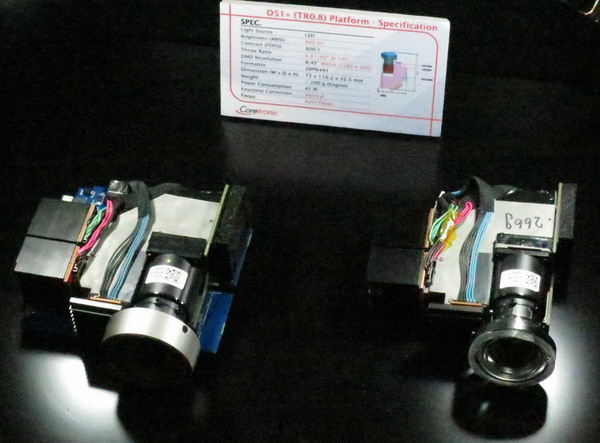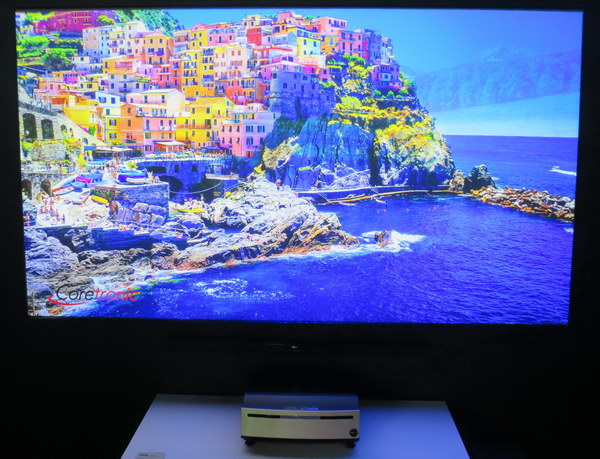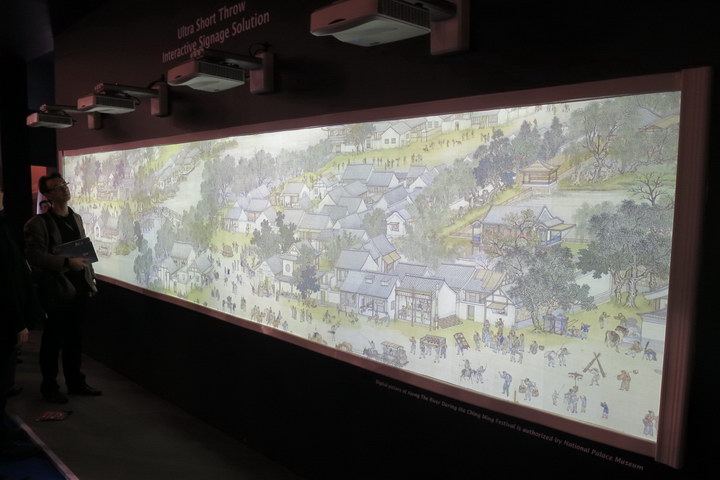Virtually all companies exhibiting at Integrated Systems Europe 2017 (ISE) in Amsterdam February 6 – 10 were showing products for sale into the InfoComm or Cedia channels. Most of the products shown are existing products available now and some are new products to be available later this year. Coretronic was different – it was showing its technology.
Coretronic is an OEM/ODM projector manufacturer and its customers are not the integrators, installers or rental and staging people that are the main attendees of ISE. Instead, their customers are the projector manufacturers exhibiting at ISE. Coretronic’s own brand business, Optoma, was exhibiting at ISE in its own booth and we have covered it separately in our Large Display Monitor ISE report (DuraCore from Optoma Offers 5 Year/30K Hour Warranty – subscription required).
Coretronic was showing three of its pico/micro projector light engines, the D30, the new D32 and the D51 platforms. The D51 platform was shown with a short-throw lens (throw ratio 0.8:1). According to the Coretronic rep, this is the LED light engine used in the Optoma ML750ST projector with 700 LED lumens and WXGA (1280 x 800) resolution. The rep said that the engine was also used in other projectors, but because of Non-Disclosure Agreements (NDAs), he could not identify either the companies or the projectors. This use of a NDA is normal in the OEM/ODM business and the OEM manufacturer cannot reveal its customers without explicit permission from the customer. Not all projectors based on the same light engine platform like the D51 are identical. When Coretronic builds a projector around a light engine for a customer, it is willing to modify the engine design, for example by using a different DLP imager to give a different resolution or changing the lens to give a different throw ratio.
 Two variations on the Coretronic D51 microprojector engine on display at ISE, This engine is used in the Optoma ML750ST and other projectors.
Two variations on the Coretronic D51 microprojector engine on display at ISE, This engine is used in the Optoma ML750ST and other projectors.
The new D32 light engine is based on LEDs and a single 0.3” TRP DLP imager with 720p resolution (1280 x 720). It produces 240 lumens output and has a contrast ratio of 475:1. With the lens as shown, it was short throw with a throw ratio of 0.72:1. One advantage of the TRP design from TI is it can pack more pixels into the same area. For example the D30 engine also uses an older 0.3” DLP and it has only WVGA resolution (854 x 480). Due to the change in tilt angle from past DLP imagers to the TRP imager, a TRP cannot simply be substituted into the D30 engine and be expected to work properly – a new optical design is required.
Coretronic was also showing its patented Multi-Color Light Architecture (MCLA) technology and projectors containing the technology. In most high-brightness projectors with solid state illumination, blue lasers produce all three colors of light. Blue light is produced directly by lasers and red and green light are produced by exciting a yellow phosphor with a blue laser. The yellow light is then split into the green and red.
Coretronic’s MCLA Logo
In the MCLA architecture, the blue light is produced by blue lasers, as is normal, the red light is produced by red lasers and the green light is produced by exciting a green phosphor by a blue laser. A variation on this design uses a yellow phosphor instead of a green phosphor. This allows the use of a yellow segment in the color wheel to increase the brightness of the projector without degrading the colorimetry as much as a white segment would.
This appears to be what is shown in the example components in the accompanying photo. The apparent gap in the phosphor wheel is not actually a gap in the wheel itself, just a gap in the phosphor. This clear segment allows the blue light from the laser to be transmitted to the DLP imager. In its description of the MCLA system Coretronic said it used “Despeckle technology for clear image presentation” without mentioning exactly what type of despeckle technology is used. Not surprising, very few laser or laser phosphor projector makers are willing to discuss despeckle technology. Interestingly, the two Coretronic brochures I picked up a ISE discuss MCLA in vague terms with emphasis on color wheel design without mentioning that the red light comes from a red laser.
Optical components in the Coretronic MCLA system shown at ISE
Coretronic also showed four projectors based on the MCLA system. The first, with no model number, was an ultra-short throw projector with 10K lumen output and a 0.37:1 throw ratio. They said this projector was targeted at retail stores and other digital signage applications. It was in what was obviously a prototype case. The second was the U40K, a 4K UHD super short throw projector targeting home theater applications. It had 4,000 lumen output, a throw ratio of 0.18:1, image sizes from 100” to 140” and DCI-P3 colorimetry. The unit had 5cm wall clearance when producing a 100” image. The unit as demonstrated had a variety of image processing components including 4K H.265 multi-media playback and support for an Android 5.0 Smart Platform. The interactive U50K on display used the same light engine design as the U40K except it had color and phosphor wheels optimized for brightness not colorimetry and produced 4500 lumens with Rec. 709 colors. It also had built-in sensors for touch interactivity and an ultra-wide image, possibly 21:9 but not stated. Probably this wide image was made by masking off part of the 4K imager used. This reduced DLP area would explain why there was only a modest brightness increase with the introduction of the yellow segment.
 Coretronic U40K projector with 4K UHD resolution, MCLA technology and DCI-P3 colorimetry
Coretronic U40K projector with 4K UHD resolution, MCLA technology and DCI-P3 colorimetry
The final MCLA projector shown was the R50K with a DLP 4K imager, 20,000 hours life, 5,300 lumens, 5,000:1 contrast and “a sealed optical engine to provide excellent dustproof capability.” This was shown with a normal throw 2:1 zoom lens in a nicely finished case. In a separate display, Coretronic was showing six standard front projection lenses and, presumably, a customer could choose which of these lenses was wanted in a product version of the R50K. A card with the lenses showed what throw ratio would be produced for each lens when used with a 0.67” or 0.96” DLP imager. The U40K and the R50K were both in nice, finished-looking cases. I wouldn’t be surprised to see one or more of these projectors showing up soon in the Optoma product line although the Optoma part number will not match the Coretronic number.
Other display cases inside the Coretronic booth showed both air and liquid cooling system technology for larger front projectors. The air cooling system was said to have a 10% higher efficiency than previous designs. Interesting, but only if you are interested (like me) on the details of what is inside a projector. This 10% cooling efficiency is important to the end user, however, even if he isn’t interested in it. Coretronic says a 10% efficiency increase leads to a 22% weight reduction, 27% size reduction and a 5dB(A) noise reduction in a typical 8000 lumen laser-phosphor projector. While there was no demonstration of it, the brochure from Coretronic discussed their sealed, dust-proof technology that provided an IP6X dust resistance rating. The company said this was especially important to projectors for the large venue, rental and staging markets.
 “Along the River During the Ching Ming Festival” shown on a 7M by 1.2M image produced by edge blending four ultra-short throw interactive Coretronic projectors.
“Along the River During the Ching Ming Festival” shown on a 7M by 1.2M image produced by edge blending four ultra-short throw interactive Coretronic projectors.
The final exhibit was on the outside of the Coretronic booth and designed to attract attention, something it did very well. It used interactive ultrashort throw projectors, each with touch sensors, that were edge blended to produce a display 120 cm high and 7M wide with 30 point touch. They were showing an image “Along the River During the Ching Ming Festival,” authorized by the National Palace Museum. This image came from a scroll so long that even on the 7M long display area, the whole scroll could not be shown. Not to worry; the 30 point multitouch system allowed viewers to scroll along the scroll, shrink it so it fit the width but did not fill the height or zoom in on individual details. The Coretronic rep said that due to the limitations of people’s heights, it is possible to make very wide interactive displays but not very high ones. No doubt, this was the rationale in masking down the 4K imager in the U50K. The projector can make a very wide display without edge blending and the entire image would be accessible by people of typical height. Use of a 4K chip in the projector allows the system to maintain good resolution. –Matthew Brennesholtz

